

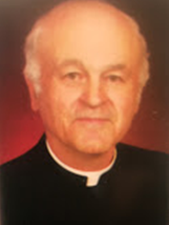
Reverend Monsignor Romano Ciotola, known to many as Father Romano, passed away on Sunday February 17,2019.
Romano was born on May 11, 1940 in the village of Cerreto in the Molise region of Italy. The village was founded in 1000. It was comprised of 300 residents at its zenith. The villagers were sharecroppers engaged in subsistance farming. The typical family had a few dozen sheep, a few cows, a horse or two, several oxen and some chickens. Arable land was scarce and the farmer tilled two or three small plots, often several miles apart. It was a cashless society and each family produced their own food. The only economic trade consisted of infrequent trading of eggs for salt and sugar.
During World War II the village had the misfortune to lie at the edge of the Gustav Line – a barrier that started at Minturno, in the province of Latina, and went straight through the Apennines stretching all the way to the city of Ortona in the province of Chieti on the opposite coast. This barrier was a defensive line used by the Nazi forces occupying Italy to defend occupied Rome from an allied attack from the South.
Pietransieri, a village 38 Kilometers north of Cerreto was also within the Gustav Line. Up until September 8. 1943, the Nazis had been allies of the Italian Fascist Party. Once the armistice occurred, the Nazis turned from guests to occupational forces.
In the beginning of November 1943, British and New Zealand armies were exerting pressure and the Italian Resistance fighters were using guerilla tactics in the local mountains to harass the Nazi occupiers. The Nazis desired to blow up the village and place mines to slow an anticipated Allied advance. As part of this defensive strategy, the Nazis demanded that the residents of Pietransieri evacuate their homes. Some villagers were forcibly moved to the nearby city of Sulmona: however, some escaped the roundup and hid in the nearby Limmari woods.
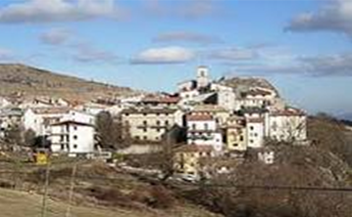
The Nazis searched the area and systematically murdered by grenades, gunfire and machine-gun fire, 128 inhabitants, including 38 children, and the corpses were left in the woods.
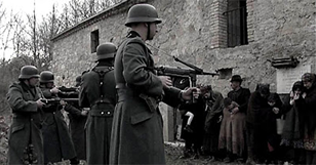
A few escaped – some by hiding under bodies. A small group of refugees accomplished the 38 Kilometer walk and found themselves in Cerreto. There, 8 of the fleeing survivors were taken in by Romano’s parents – Felice and Silvia Ciotola. The men were cold, their clothes were tattered, and they were hungry. They had slowly worked their way south, avoiding the numerous Nazi patrols in the region.
The decision of Romano’s parents to take the refugees into their home for the Winter of 1943 was an act of hospitality and sacrifice. The significance of the noble and unselfish act is more meaningful with a look at the situation. In good times, before the war, feeding a family was difficult. The harvest in the fall filled two wooden coffers. One had flour derived from the wheat harvest. The other, the cornmeal derived from the corn. If the boxes became empty during the winter, there was no safety net – your family starved. In one pre-war winter Romano’s father ran out and was forced to walk the 15 Kilometers in mid-winter to barter a lamb for flour.
The refugees came in November of 1943 during the war. Because of the war, food was very scarce. The Nazis had occupied Cerreto and the troops had taken all livestock and any food that the villagers had failed to hide. (Expecting the occupation, the villagers had butchered as many animals as possible and buried the meat in clay jars.) With a family of five – Romano and two older sisters – the decision to feed and take care of 8 desperate fellow countrymen was an astonishing act of unselfishness.
In a homily at Our Lady Of Victory Parish, Romano explained that it was this courageous act of kindness and sacrifice by his parents that was the basis of his vocation to serve others as a Priest.
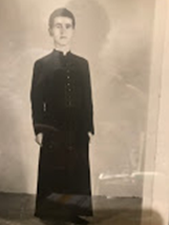
At the young age of 11, as a result of the strong religious faith instilled upon him by his parents, Romano discerned a religious vocation and entered a preparatory boarding school in Trivento, Italy, for students interested in entering the priesthood. Then, at age 17, he entered the St. Pius X Pontifical Seminary in Chieti, Italy, for his first year of Seminary College.
The following year, 1958, Romano emigrated to America with his family to join his father and older sister who had come two years earlier. Then at age 18, he attended St. Charles Seminary in Columbus and in 1961 proceeded to Mt. St. Mary Seminary in Cincinnati, where he completed his theological studies. He received a Master of Divinity Degree at St. John’s College in Cleveland, Ohio, and also studied at the North American College in Rome.
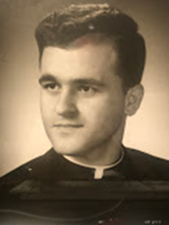
After Romano’s Ordination on May 29, 1965, he was assigned as an Associate Pastor and High School religion teacher in several parishes and schools in Ohio. He was assigned as Associate Pastor at St. Matthew the Apostle Parish, Gahanna, Ohio, also serving as a Religion teacher at Bishop Hartley High School. He then served at St. Agnes Parish, Columbus, also serving as a Religion teacher at Bishop Ready High School; then served as Assistant Pastor in Dennison, Ohio at Immaculate Conception Catholic Parish, also serving as a Religion teacher at Tuscarawas Central Catholic High School. He then was assigned to Blessed Sacrament Parish in Newark, Ohio and served as a Religion teacher at Newark Catholic High School.

In 1976 he served as Pastor of St. Patrick Parish in London, Ohio. In 1987 he was assigned as Pastor to Our Lady of Perpetual Help Parish in Grove City, Ohio. In July 2000, Romano arrived at Our Lady of Victory Parish, his original home parish and the location of his family and many relatives and friends from his village of birth. He has served his parish family there for 18 years.
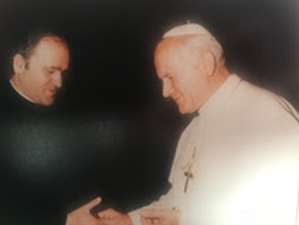
Romano was honored to have been in the presence of three Saints – Pope John Paul II, Mother Teresa and Padre Pio.



Romano always endeavored to bring a faithful community closer to God. To accomplish that goal, with the support of Our Lady of Victory Parish and other friends, he built a church for the faithful in the village of Nueva Esperanza, Honduras – Iglesia Nuestra Señora. He also participated in the upkeep of the nearby orphanage at Montaña de Luz. Romano and Our Lady of Victory Parish provided financial support to Chibley Cardinal Longlois of the Diocese of Les Cayes in Haiti for the education of Seminarians and for hurricane reconstruction . He also financially supported the church in his native village – La Chiesa di San Felice Cantalice.
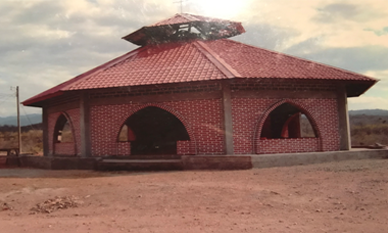
He was very proud of his Italian heritage and led many tours there for his friends and parishioners to enjoy the culture, art, churches, food, and people.



Romano was greatly loved and respected by his family. He provided the strong foundation and support that kept the family together. No family wedding or Baptism would have been complete without him. His personal touch will be forever cherished.
Touching upon the gift of love of bringing people together and focusing on hospitality, the parishes that Romano served became communities and families.
Romano was a humble and selfless man who changed the lives of all that he met. His love is a faithful reminder of what it means to be a servant of God.